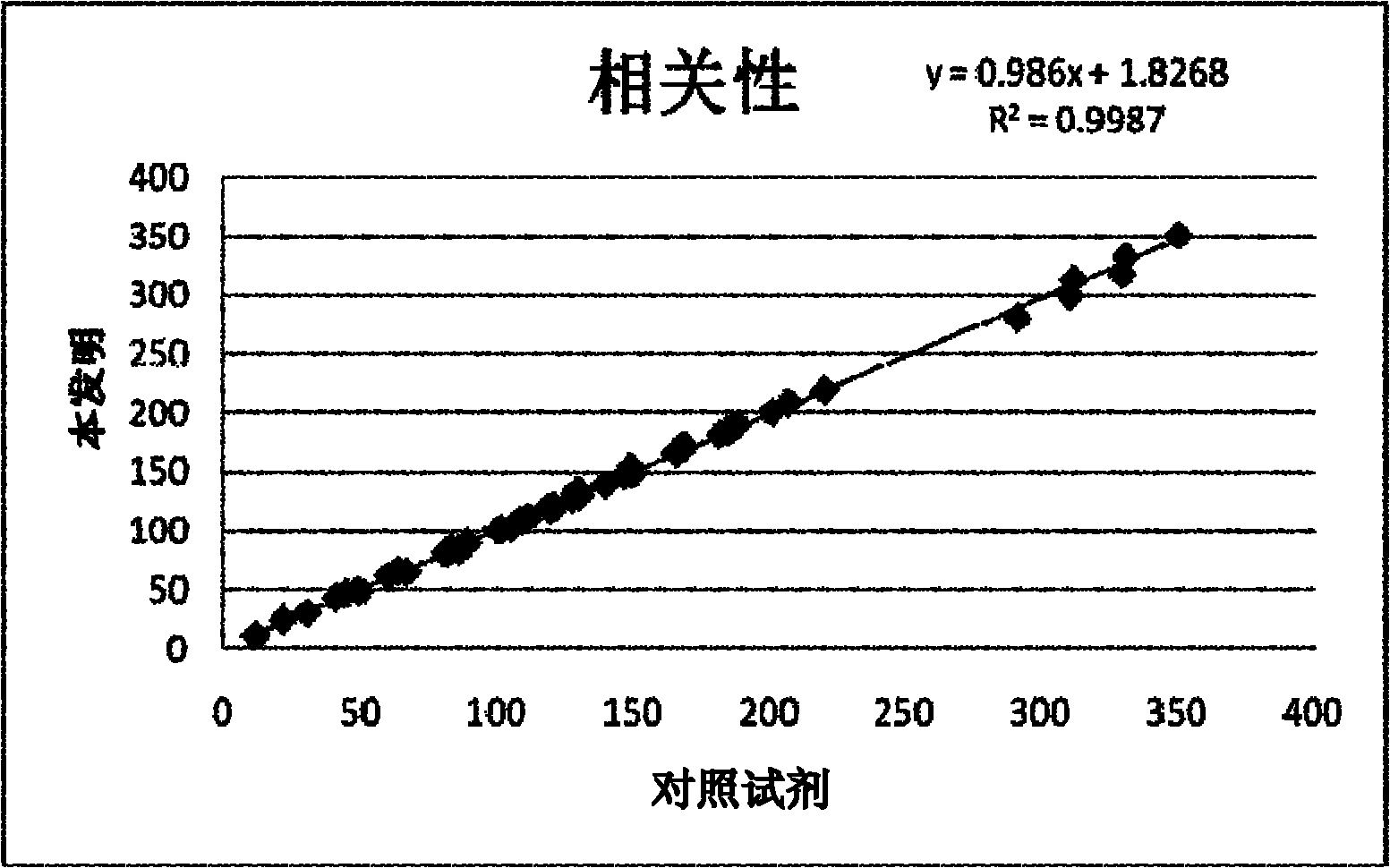Method for detecting 1,5-anhydro sorbitol and related diagnostic kit
A technology of sorbitan and reagent kits, which is applied in the field of clinical biochemical diagnosis, can solve the problems of high cost of reagent kits, and achieve the effects of ensuring stability, convenient use, and strong removal ability
- Summary
- Abstract
- Description
- Claims
- Application Information
AI Technical Summary
Problems solved by technology
Method used
Image
Examples
Embodiment 1
[0090] Click on the ingredients and dosage to configure the 1,5-AG diagnostic kit. In the present invention, unless otherwise specified, percentages are mass-volume ratios.
[0091] Reagent 1
[0092] Phosphate buffer 100mM
[0093] Adenosine diphosphate 5mM
[0095] ADP-dependent hexokinase 20U / ml
[0096] Tio-NAD 1g / L
[0098] Reagent 2
[0099] Tris buffer 10mM
[0100] 1,5-anhydroglucitol-6-phosphate dehydrogenase 10U / ml
[0101] NADH 6g / L
[0103] Set on the automatic biochemical analyzer (Olympus-400): reaction temperature 37°C, reaction time 1.5 minutes, test wavelength 405nm, test sub-wavelength 540nm. The ratio of the tested potassium ion sample to the reagent is: sample: reagent 1: reagent 2 = 5 μl: 180 μl: 60 μl, and the reaction is a drop reaction.
[0104] First add the sample and reagent 1, the two are automatically mixed in the automatic biochemical analyzer, dete...
Embodiment 2
[0107] According to Embodiment 1, a sugar removal system is added to configure a 1,5-AG detection kit.
[0108] Reagent 1
[0109] Tris-HCl 100mmol / L
[0110] Adenosine diphosphate 5mmol / L
[0111] Adenosine triphosphate 5mmol / L
[0112] Hexokinase 5U / ml
[0113] Glucose-6-phosphate 5U / ml
[0114] Hexose phosphate isomerase 10U / ml
[0115] Magnesium chloride 5mmol / L
[0116] ADP-dependent hexokinase 20U / ml
[0117] Tio-NAD 1g / L
[0119] Reagent 2
[0120] Tris buffer 10mM
[0121] 1,5-anhydroglucitol-6-phosphate dehydrogenase 10U / ml
[0122] NADH 6g / L
[0123] Sodium azide 0.5g / L
[0124] Using the experimental method of Example 1, the sugar removal system was tested.
[0125] sample
[0126] 1,5-AG pure product solution (150umol / l)
[0127] According to the above data, the sugar removal system can remove the interference of glucose on the detection, but there is still some interference of glucose on the system.
Embodiment 3
[0129] According to Embodiment 1, a sugar removal system is added to configure a 1,5-AG detection kit.
[0130] Reagent 1
[0131] Tris-HCl 100mmol / L
[0132] Adenosine diphosphate 5mmol / L
[0133] Adenosine triphosphate 5mmol / L
[0134] Glucokinase 5U / ml
[0135] Glucose-6-phosphate 5U / ml
[0136] Hexose phosphate isomerase 10U / ml
[0137] Magnesium chloride 5mmol / L
[0138] ADP-dependent hexokinase 20U / ml
[0139] Tio-NAD 1g / L
[0140] Sodium azide 0.5g / L
[0141] Reagent 2
[0142] Tris buffer 10mM
[0143] 1,5-anhydroglucitol-6-phosphate dehydrogenase 10U / ml
[0144] NADH 6g / L
[0145] Sodium azide 0.5g / L
[0146] Using the experimental method of Example 1, the sugar removal system was tested.
[0147] sample
[0148] According to the above data, the sugar removal system can remove the interference of glucose on the detection, which is obviously stronger than that of Example 3.
PUM
 Login to View More
Login to View More Abstract
Description
Claims
Application Information
 Login to View More
Login to View More - R&D
- Intellectual Property
- Life Sciences
- Materials
- Tech Scout
- Unparalleled Data Quality
- Higher Quality Content
- 60% Fewer Hallucinations
Browse by: Latest US Patents, China's latest patents, Technical Efficacy Thesaurus, Application Domain, Technology Topic, Popular Technical Reports.
© 2025 PatSnap. All rights reserved.Legal|Privacy policy|Modern Slavery Act Transparency Statement|Sitemap|About US| Contact US: help@patsnap.com



